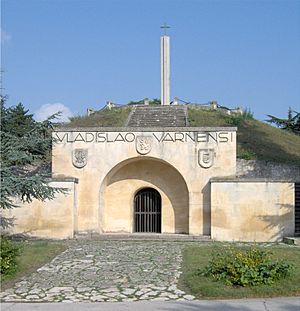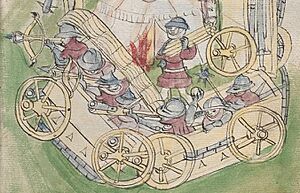Battle of Varna facts for kids
Quick facts for kids Battle of Varna |
|||||||
|---|---|---|---|---|---|---|---|
| Part of the Crusade of Varna and the Ottoman wars in Europe | |||||||
 The Crusaders were trapped below. Their defeat permitted the Conquest of Constantinople. Beyond the Ottoman Sultan and the Janissaries was the cradle of medieval Bulgaria. |
|||||||
|
|||||||
| Belligerents | |||||||
| Ottoman Empire | Varna Crusaders:
|
||||||
| Commanders and leaders | |||||||
| Murad II Prince Mehmed Karaca Pasha |
Stephen III Báthory † Michael Szilágyi Franko Talovac Jan Chapek Simon Rozgonyi † John de Dominis † Rafael Herczeg |
||||||
| Strength | |||||||
|
Around 60,000
|
20,000 (6,000 Hungarians, 5,000 troops by Hunyadi, 4,000 Polish cavalry, 4,000 Wallachian cavalry, 1,000 Crusaders recruited by Cesarini) |
||||||
| Casualties and losses | |||||||
| Heavy casualties 10,000–15,000 |
About half the army 65,000 |
||||||
The Battle of Varna was a big fight that happened on November 10, 1444. It took place near the city of Varna in what is now Bulgaria. In this battle, the Ottoman army, led by Sultan Murad II, fought against a group of Crusaders. These Crusaders were led by King Władysław III of Poland and John Hunyadi, a powerful Hungarian leader. The battle was the last major event of the Crusade of Varna. This crusade was a final attempt to stop the Ottoman Empire from expanding further into Europe.
Contents
Why the Battle of Varna Happened
After King Sigismund of Hungary died in 1437, the Hungarian Kingdom faced problems. His successor, King Albert, ruled for only two years and died in 1439. This left his wife, Elizabeth, with a baby on the way.
Hungarian nobles then asked the young King Władysław III of Poland to become their king. They hoped he would help them defend against the growing Ottoman Empire. After becoming King of Hungary, Władysław stayed there. He ruled alongside the important nobleman John Hunyadi.
Peace Treaty and New Plans
The Ottoman Sultan Murad II had signed a ten-year peace treaty with Hungary in 1443. This happened after Hunyadi's successful "long campaign" against the Ottomans. After making peace with another group in Anatolia, Sultan Murad II decided to step down. He gave the throne to his 12-year-old son, Mehmed II.
However, a church leader named Julian Cesarini told King Władysław III to break the peace treaty. Cesarini argued that the treaty was not valid because it was made with non-Christians. So, Hungary worked with Venice and Pope Eugene IV to create a new Crusader army. This army was led by Hunyadi and King Władysław III. When Sultan Murad II heard about this, he was called back to lead the Ottoman army, even though his son Mehmed II wanted to fight.
Preparing for the Battle
The Crusader army was made up of soldiers from many different places. Most of them were from Hungary, Poland, and Bohemia (about 16,000 soldiers). There were also 4,000 soldiers from Wallachia. Smaller groups came from the Papal States, the Teutonic Order, Bosnia, Croatia, Bulgaria, Lithuania, and Ruthenia. Croatian and Bosnian troops were led by a nobleman named Franko Talovac.
Ships from the Papal States, Venice, and Burgundy tried to block the Dardanelles strait. This was meant to stop the Ottoman army from crossing. Another group of ships tried to block the Bosphorus strait. However, both attempts failed. The main Ottoman army, including the Sultan, crossed the Bosphorus on October 18, 1444.
The Hungarian army moved quickly. They went past Ottoman forts. Local Bulgarians from places like Vidin and Nicopolis joined the army. Fruzhin, a Bulgarian prince, also joined with his own soldiers. On October 10, about 7,000 Wallachian cavalrymen, led by Mircea II, joined the Crusaders near Nicopolis.
Some Armenian refugees who lived in Hungary also fought with the Christian forces at Varna.
Setting Up for the Fight
On the evening of November 9, a large Ottoman army arrived near Varna. It had about 40,000 to 60,000 soldiers. During a meeting that night, Cardinal Julian Cesarini suggested that the Crusaders should retreat quickly. But the Crusaders were stuck between the Black Sea, Lake Varna, steep hills, and the Ottoman army.
Cesarini then suggested using a special defense called a Wagenburg of the Hussites. This was a circle of wagons used as a fort. He thought they should wait for the Christian fleet to arrive. Hungarian nobles and commanders from Croatia and Bohemia agreed with him. However, the young King Władysław (who was only 20) and Hunyadi disagreed. Hunyadi said, "To escape is impossible, to surrender is unthinkable. Let us fight with bravery and honor our arms." King Władysław agreed and gave Hunyadi command of the army.
How the Armies Lined Up
On the morning of November 10, Hunyadi arranged the Crusader army. There were about 20,000 Crusaders. They formed a curved line between Lake Varna and the Franga plateau, stretching about 3.5 kilometers.
- The center of the Crusader army had 3,500 soldiers. These were the king's Polish and Hungarian bodyguards, Hungarian mercenaries, and soldiers from Hungarian nobles.
- The Wallachian cavalry was kept in reserve behind the center.
- The right side of the army had 6,500 soldiers. They were led by John de Dominis, a bishop, and Cardinal Cesarini. This side included German mercenaries, Bosnians, and Croats.
- The left side had 5,000 soldiers. They were led by Michael Szilágyi, Hunyadi's brother-in-law. This group included soldiers from Transylvania, Bulgarians, German mercenaries, and Hungarian nobles.
- Behind the Hungarian forces, closer to the Black Sea, was the Wagenburg. This wagon-fort was defended by 300 to 600 Czech and Ruthenian mercenaries, along with Poles, Lithuanians, and Wallachians. Each wagon had 7 to 10 soldiers and was equipped with cannons called bombards.
The Ottoman army's center included the Janissaries (elite Ottoman soldiers) and other troops. Sultan Murad II watched and directed the battle from a small hill. The Janissaries dug ditches and built two fences for defense. The Ottoman right side had elite cavalry and other soldiers. The left side had light cavalry and other forces. Ottoman archers and light cavalry were also placed on the Franga plateau.
The Battle Begins
The battle started with the Ottoman light cavalry attacking the Croatian soldiers. The Christian forces on the left side fired their cannons and firearms, stopping the attack. The Christian soldiers then chased the Ottomans, but they became disorganized. Ottoman cavalry then attacked them from the side. The Christian right wing tried to escape to a small fort, but most of them were killed in the marshy land around Varna Lake. Cardinal Cesarini also died there. Only the troops of Franko Talovac managed to get back to the Wagenburg.
The other Ottoman flank attacked the Hungarians and Bulgarians led by Michael Szilagyi. Their attack was stopped and pushed back. Then, the Ottoman cavalry attacked again. Hunyadi decided to help and told King Władysław to wait for him to return. Hunyadi then rode forward with two groups of cavalry.
But the young king, ignoring Hunyadi's advice, rushed with 500 of his Polish knights directly at the Ottoman center. They tried to break through the Janissary soldiers and capture Sultan Murad. They almost succeeded! However, in front of Murad's tent, King Władysław's horse either fell into a trap or was stabbed. The king was then killed by a mercenary named Kodja Hazar. With their king dead, the remaining Crusader cavalry lost hope and were defeated by the Ottomans.
When Hunyadi returned, he desperately tried to find the king's body, but he couldn't. All he could do was organize the retreat of what was left of his army. Many thousands of soldiers died in the chaos. The king's head and body were never found.
What Happened After the Battle

After the battle, Hunyadi reached the Danube River. However, he was captured by Vlad Dracul in Wallachia. He was held for a ransom. Hunyadi was released when Hungarian nobles loyal to him threatened to attack Vlad Dracul. Another story says that Wallachian border guards captured him by mistake, not knowing who he was, and Vlad Dracul released him once they met. After King Władysław III died, Hunyadi became a very important and powerful Hungarian noble. He became the Governor of Hungary in 1446.
The death of King Władysław III meant that Hungary was now led by the four-year-old Ladislaus Posthumous. In Poland, Casimir IV Jagiellon became king after three years.
The Ottoman victory at Varna was very costly for them, but it was a major win. This victory, along with another Ottoman victory in the Second Battle of Kosovo in 1448, stopped European countries from sending much help to the Byzantines when the Ottomans attacked Constantinople in 1453.
Only a later European victory at the Siege of Belgrade in 1456 stopped the Ottomans from conquering even more of Europe. Hungary was safe for about 70 more years after that victory. But in 1526, the Hungarian army was crushed by the Ottomans at the Battle of Mohács. This led to Hungary losing its independence for almost 400 years.
Legacy of the Battle
The Battle of Varna was a very important event. The Ottomans had removed a major obstacle to their expansion into central and eastern Europe. Many Europeans later became Ottoman subjects.
The Polish king who died in the battle is remembered as Ladislaus of Varna (Władysław III Warneńczyk).
The Battle of Varna is honored on the Tomb of the Unknown Soldier, Warsaw, with the words "WARNA 10 XI 1444".




